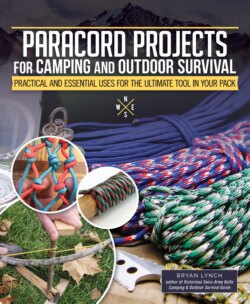Читать книгу Understanding Wood Finishing, 3rd Revised Edition - Bryan Lynch - Страница 8
На сайте Литреса книга снята с продажи.
ОглавлениеINTRODUCTION
Allied troops parachuting into the Netherlands in 1944.
The History of Paracord
To understand why paracord is so useful, we should know a little history behind this amazing cordage product. In 1935, American chemist Wallace Carothers (1896–1937), working for DuPont, created a new synthetic material that came to be called nylon. At that time, parachutes were primarily made from silk. However, silk was in short supply because it relies on the silkworm to make it—a slow method of production. Since nylon was quicker to produce, and stronger, it replaced silk in parachutes. Nylon was also used to make the suspension lines—parachute cord, aka paracord—for the parachutes. When World War II paratroopers landed on the ground, they would cut the cordage from their chutes and use it to make straps and tie up gear.
Perfect Paracord!
Did you know that paracord is awesome adventure material?
• It’s mildew resistant.
• It shrinks only a little when wet.
• Just about the only thing that will degrade it over time is ultraviolet light.
Pictured from top to bottom: type 95 paracord with one yarn, type 325 paracord with three yarns, and type III 550 paracord with seven yarns.
Although it was (and to some extent, still is) primarily a military product, paracord has many civilian uses today. It is especially popular with outdoorspeople, emergency responders, and crafters. It has become so popular, and even trendy, that you’ve probably seen people wearing paracord bracelets and other accessories as part of their daily wardrobe.
There are several different types of paracord but the most common is type III, often referred to as 550 cord. One piece of cordage can hold 550 pounds (250 kilograms) of static weight. (But don’t grab your 550 cord and head for the nearest mountain! Paracord should not be substituted for an actual climbing rope.)
It is important to know the difference between knockoff paracord and real paracord—especially if your life is on the line (pun intended!). Read on to find out how.
There are three bracelet projects in this book—see here when you’re ready to make one.
The Anatomy of Paracord
To properly identify real paracord, we need to break it down into its parts. First, there is the outer woven sheath. Then there is the inner core of strands that are called “yarns.” The most common type of paracord, type III 550, has 7–9 yarns. Don’t get confused if you hear people talking about paracord and using the word “strands,” or “inner strands”—they are referring to the yarns. The yarns, then, are made up of even finer threads of nylon. These can be pulled apart into thinner and thinner pieces depending on what they are needed for.
This structure is what gives paracord its amazing strength relative to its size and weight. It also gives you much more cordage than you think you have, if you are willing to pull the yarns out of the sheath and tie them together end to end.
To get an estimate of how much total yarn cordage you have, add the number of yarns you have plus one (for the outer sheath). Take that number and multiply it by the original length of the paracord. For example, type III paracord generally has seven yarns surrounded by the outer sheath. Add those two numbers together and you get eight. If I have 1 ft. (30 cm) of cordage, I multiply eight times one. That gives me approximately 8 ft. (2.4 m) of total cordage when the paracord is pulled apart. Obviously that number increases as you increase the original length of intact paracord. A 10 ft. (3 m) piece would produce almost 80 ft. (24 m) of usable cordage! Of course, always keep in mind that some length will be lost to the knots that join the lengths of yardage together.
Type III 550 paracord with seven inner yarns.
I cut approximately 1 ft. (30 cm) of type III paracord and laid out the strands below the outer core. If you tie all these ends together, you will have close to 8 ft. (2.4 m) of cordage. Note: Some length is lost in the knots joining the yarns together.
True Paracord
Not all paracord is created equal. The kind of paracord that you want, and what is used in this book, is “mil-spec,” which means that it meets military specifications. Both the yarns and the outer sheath must be made of 100% nylon.
Some knockoff paracord is manufactured with a nylon sheath and inner strands made of polyester. Most people can’t tell the difference between polyester and nylon just by looking at them. Here is a quick test you can do to find out what you’re looking at. (But don’t do this in the store before purchasing it!)
All you need is a cutting tool and a lighter. When two pieces of nylon are melted and pushed together, they will stick to one another like glue. When a piece of nylon and a piece of polyester are melted and pushed together, they will not stick together. So, if you are unsure about the materials in your paracord, try this test. Never risk your life by using subpar materials.
PARA-TIP: Check for Strength
If you are reusing paracord, it’s a good idea to check its integrity first. Simply pull it through your hands and check the nylon sheath for any nicks or fraying. If you find a damaged section, cut it out or use the cord for a light-duty task.
